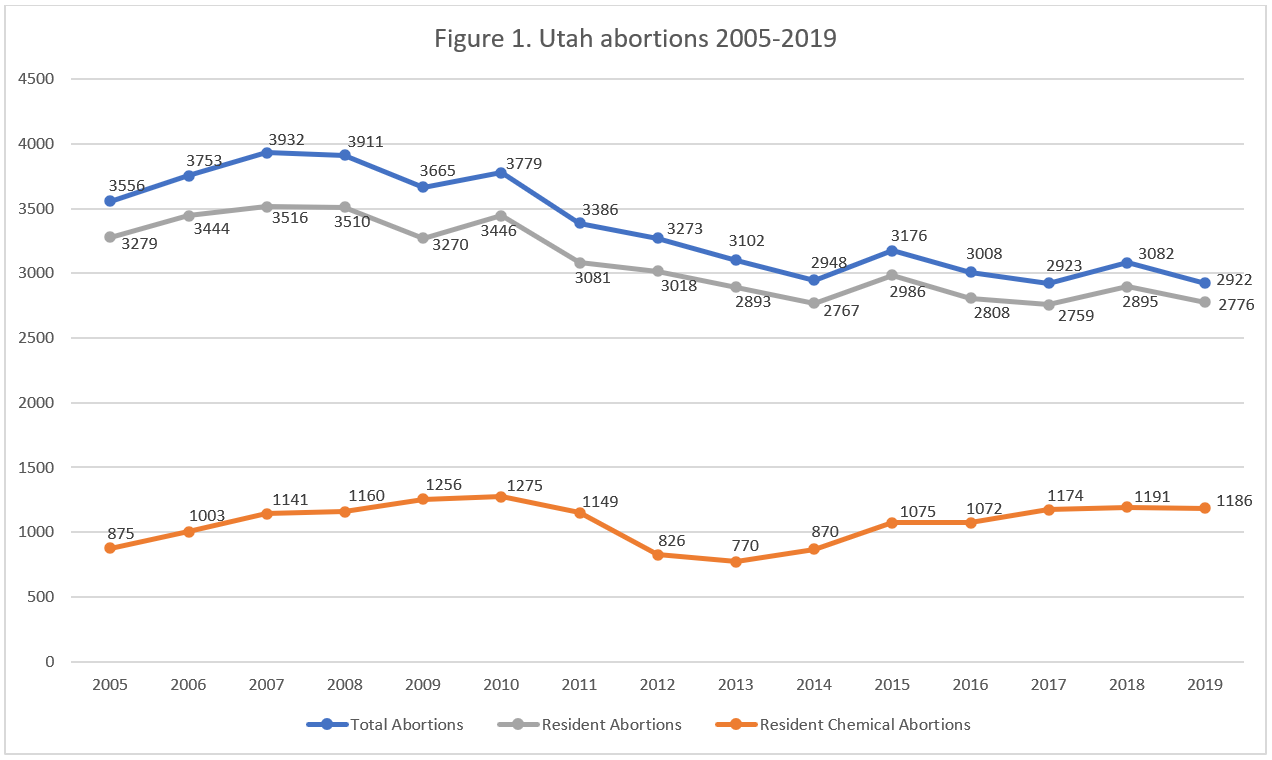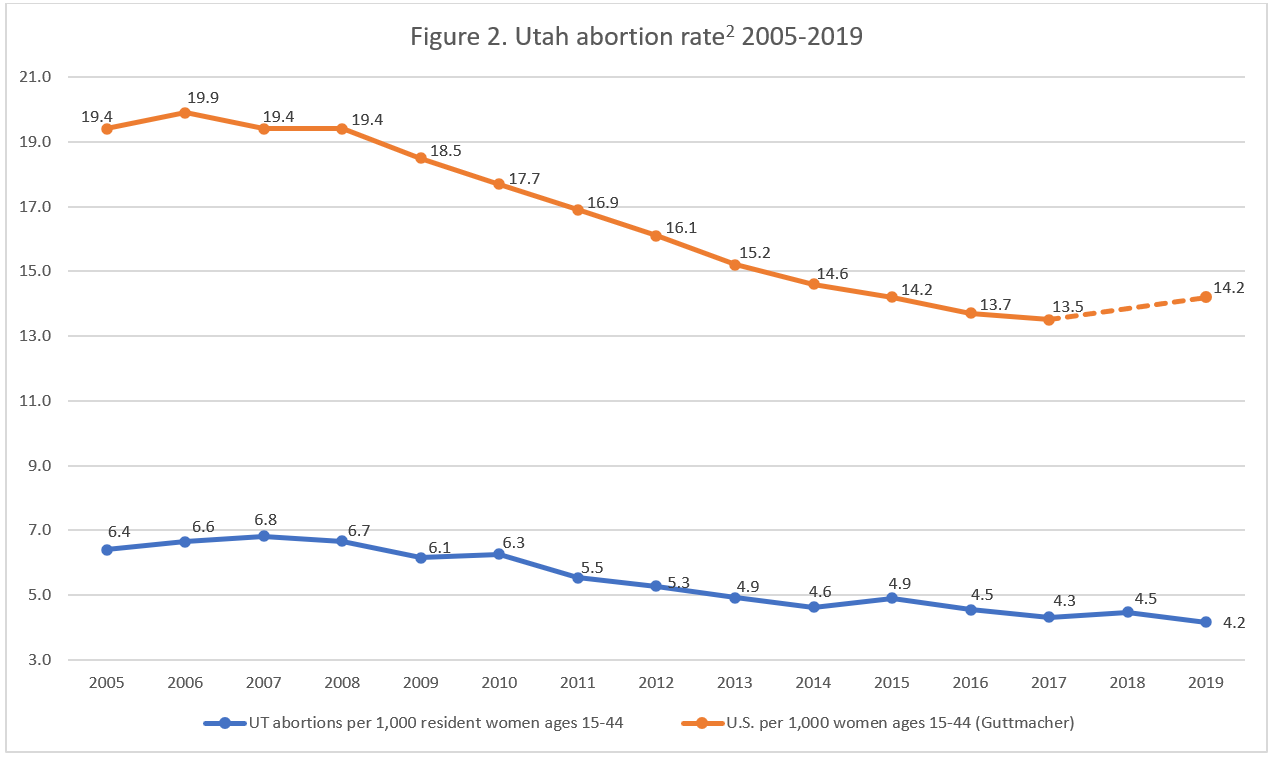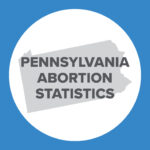Abortion Reporting: Utah (2019)
Utah’s 2019 abortion report was published online by the Utah Department of Health in February 2022, showing that abortions decreased in 2019.
Changes in Utah Abortions, 2018-2019

The change in total abortions and chemical abortions reflects abortions performed on Utah residents, while the change in the abortion rate reflects all abortions occurring in the state. The report does not include information on Planned Parenthood’s Utah abortion market share.
Abortion Totals and Trends
Utah reported 2,922 abortions in 2019, down five percent from the previous year. Of these, 2,776 abortions were performed on residents, a decrease of four percent from 2018 (Fig. 1). There were 1,186 chemical abortions performed on Utah residents in 2019, essentially unchanged from the 2018 total. Chemical abortions made up 43 percent of Utah resident abortions in 2019. The Charlotte Lozier Institute (CLI) estimates that Utah’s 2019 abortion rate was 4.2 abortions per 1,000 women ages 15-44, far lower than the national rate (Fig. 2). Of the 48 reporting areas nationwide that shared 2018 and 2019 abortion data with the Centers for Disease Control in its 2019 abortion surveillance report,, 23 reported that abortions decreased in 2019.
State Report Summary
In 2019, 95 percent of the abortions reported in Utah were performed on state residents. Five percent were performed on women from other states, including just under two percent each on women from Idaho and Wyoming and not quite one percent on Nevada women. Most of the information in Utah’s abortion report is for abortions performed on Utah residents only.
Thirteen percent of Utah abortions were performed on girls under the age of 20, a higher percentage than in most other states. This includes three percent of the abortions that were performed on minor girls under the age of 18. Thirty-one percent of Utah resident abortions were obtained by women ages 20 to 24. Twenty-six percent of the abortions were performed on women ages 25 to 29, and 27 percent were on women ages 30 to 39. Three percent of the abortions were performed on women ages 40 and older.
Sixty percent of Utah resident abortions were performed on non-Hispanic white women, and five percent were on non-Hispanic black women. Six percent of the abortions performed on Utah residents were obtained by Asian or Pacific Islander women, while one percent were performed on Native American women and 0.3 percent were on women of other races. Twenty-seven percent of the abortions were on Hispanic women, and one percent were on women whose race was not reported. CLI estimates that the non-Hispanic black abortion rate was more than four times as high as the non-Hispanic white rate in 2019.
Forty percent of the abortions performed on Utah women were obtained by women who had graduated from high school or earned a GED, and another 40 percent were on women with more than a high school education. Nine percent of Utah abortions were performed on women who had not finished high school, and 12 percent were on women whose level of education was not reported. Seventy percent of the abortions were performed on unmarried women, and 29 percent were performed on married women, including women who were separated from their spouses. Marital status was not reported for 0.6 percent.
Over half the abortions (51 percent) were performed on women with no previous live births. Nineteen percent were on women with one live birth, and 30 percent were obtained by women with two or more prior births. Seventy-seven percent of the abortions were performed on women who reported no prior abortions, while not quite 18 percent were on women with one prior abortion and six percent were on women with more than one previous abortion.
Just over 50 percent of the abortions were performed on women who said they were using contraception when they became pregnant, and just under 50 percent were on women who were not using contraception. Contraceptive history was not reported for five abortions. Of the women using contraception, five percent reported using a highly effective method (which Utah lists as implant and IUD), 27 percent used a moderately effective method (shot, pill, patch, ring, diaphragm), and 68 percent used one of the least effective methods (condom, withdrawal, sponge, spermicide, natural family planning). Reporting improved from 2018, when contraceptive usage was unknown for over half the abortions. Utah’s categories match those used by the Centers for Disease Control; however, some forms of natural family planning are very reliable.
A majority of Utah resident abortions, 57 percent, were surgical abortions. Forty-three percent were chemical abortions. The numbers of hysterotomy or hysterectomy abortions and intrauterine instillation procedures, as well as the number of abortions for which the type of procedure was not reported, were suppressed. Five abortions were reported to have resulted in complications at the time the form was filled out. No complications were reported for 63 percent of the abortions, while for 37 percent it was not reported whether complications occurred.1
Twelve percent of Utah abortions were performed earlier than five weeks of gestation. Twenty-three percent were performed between five and six weeks, and 32 percent were reported between seven and eight weeks of gestation. Fourteen percent occurred between nine and 10 weeks, and eight percent were reported between 11 and 12 weeks. Four percent were reported between 13 and 14 weeks of gestation. Six percent of Utah resident abortions were performed at 15 weeks of gestation or later, with five percent performed between 15 and 20 weeks and one percent at 21 weeks or later.
Utah asks women to share their reasons for choosing abortion. In 2019, 65 percent of the abortions were performed for socioeconomic reasons, and 29 percent were elective. Three percent of the women reported seeking abortion due to contraceptive failure. One percent of the abortions were performed because the unborn baby had a medical condition. Eight abortions were due to rape, while six abortions were performed for the mother’s mental health and another six were performed because the mother’s life was in danger. One percent of the abortions were performed for unknown reasons, and the number of abortions performed due to drug or radiation exposure was suppressed.
July had the highest abortion total (252), while September had the lowest (201).
Planned Parenthood
Two abortion centers are active in Utah, one of which is operated by Planned Parenthood. Utah’s abortion report does not indicate the number of abortions performed at each abortion center. However, Planned Parenthood’s Utah affiliate shares its abortion totals in its annual report. The data in the annual report spans from July to June of the following year. Averaging the abortion totals in Planned Parenthood Utah’s 2019 and 2020 annual reports shows that Planned Parenthood performed approximately 2,130 abortions in calendar year 2019, 73 percent of the Utah total.
State Ranking
In 2016, CLI evaluated abortion reporting across the country, and Utah’s reporting was ranked at 6th best. Utah could improve its reports by incorporating information on all abortions occurring in the state, not just those performed on state residents. Utah could also require all healthcare providers, particularly emergency rooms and urgent care facilities, to report abortion-related complications they treat. Additionally, Utah could release reports on a faster schedule.


- Statistics on abortion complications reported here represent a minimal number of deaths and complications, as this data is collected in a non-systematic and non-verifiable way. As such, this data cannot be used to calculate either an accurate abortion mortality rate or an accurate abortion complication rate for the state.
- Rates were calculated by CLI using the following formula: (total number of abortions performed in Utah ÷ number of resident women ages 15-44) x 1,000. Rates may differ slightly from previous CLI articles due to revised population estimates. Population estimates were obtained from CDC WONDER.
























